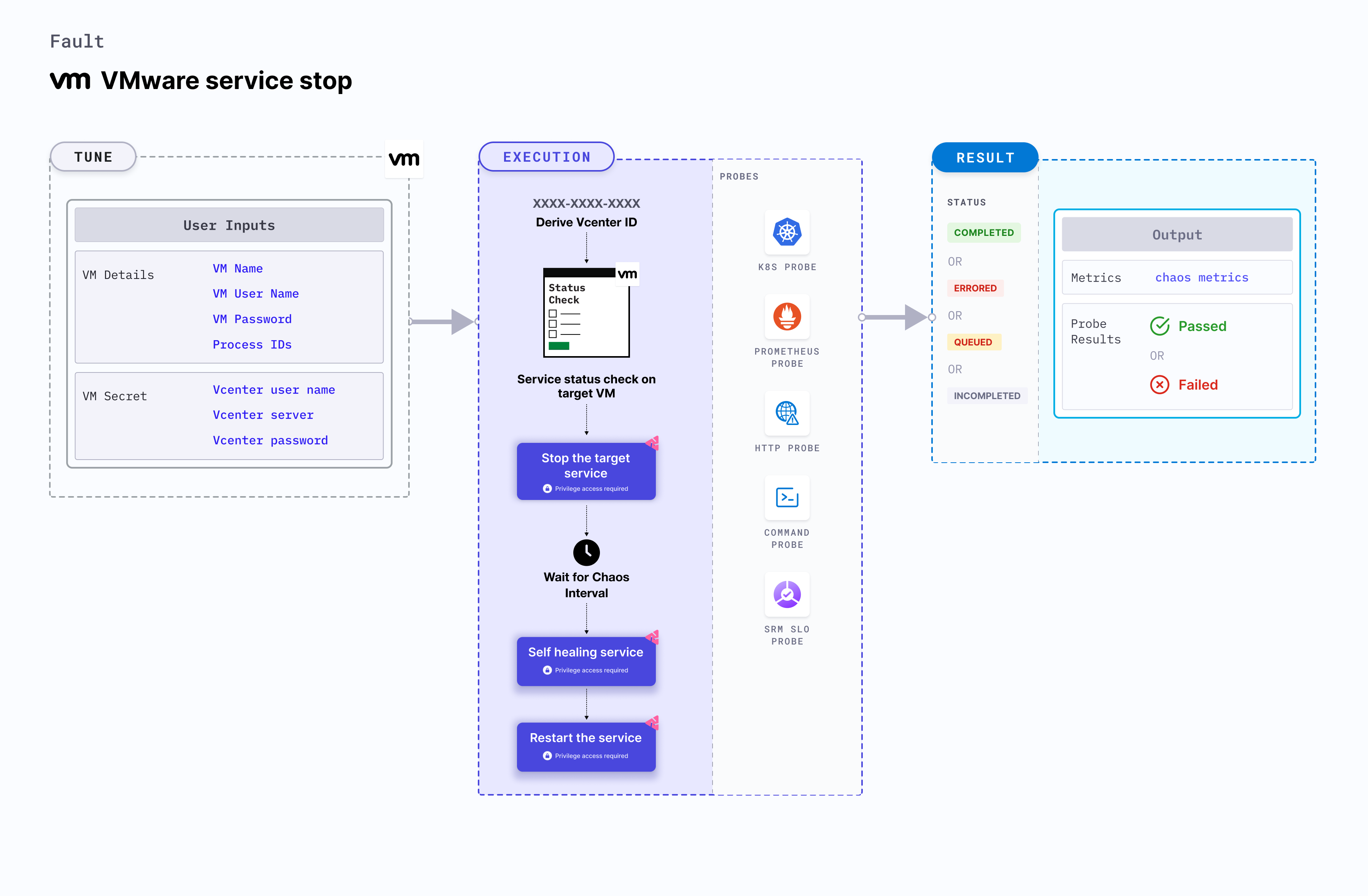VMware service stop
VMware service stop stops the target system services running on a Linux OS based VMware VM. It determines the performance and resilience of the application (or service) running on the VMware VMs.

Use cases
- VMware service stop determines the resilience of an application to random halts.
- It determines how efficiently an application recovers and restarts the services.
Prerequisites
- Kubernetes > 1.16 is required to execute this fault.
- Execution plane should be connected to vCenter and host vCenter on port 443.
- The VM should be in a healthy state before and after injecting chaos.
- VMware tool should be installed on the target VM with remote execution enabled.
- The target processes should exist within the VM.
- Appropriate vCenter permissions should be provided to access the hosts and the VMs.
- Kubernetes secret has to be created that has the Vcenter credentials in the
CHAOS_NAMESPACE. VM credentials can be passed as secrets or as aChaosEngineenvironment variable. Below is a sample secret file:
apiVersion: v1
kind: Secret
metadata:
name: vcenter-secret
namespace: litmus
type: Opaque
stringData:
VCENTERSERVER: XXXXXXXXXXX
VCENTERUSER: XXXXXXXXXXXXX
VCENTERPASS: XXXXXXXXXXXXX
Mandatory tunables
| Tunable | Description | Notes |
|---|---|---|
| VM_NAME | Name of the VM where the target processes reside. | For example, ubuntu-vm-1. |
| VM_USER_NAME | Username of the target VM. | For example, vm-user. |
| VM_PASSWORD | User password for the target VM. | For example, 1234. Note: You can take the password from secret as well. |
| SERVICE_NAMES | Name of the target service. | For example, nginx. For more information, go to service name. |
Optional tunables
| Tunable | Description | Notes |
|---|---|---|
| SELF_HEALING_SERVICES | Set to enable if the target service is self-healing. | Defaults to disable. For more information, go to self-healing services. |
| TOTAL_CHAOS_DURATION | Duration that you specify, through which chaos is injected into the target resource (in seconds). | Defaults to 30s. For more information, go to duration of the chaos. |
| CHAOS_INTERVAL | Time interval between two successive instance terminations (in seconds). | Defaults to 30s. For more information, go to chaos interval. |
| SEQUENCE | Sequence of chaos execution for multiple instances. | Defaults to parallel. Supports serial sequence as well. For more information, go to sequence of chaos execution. |
| RAMP_TIME | Period to wait before and after injecting chaos (in seconds). | For example, 30s. For more information, go to ramp time. |
| DEFAULT_HEALTH_CHECK | Determines if you wish to run the default health check which is present inside the fault. | Default: 'true'. For more information, go to default health check. |
Self-healing services
It specifies whether the target service has the ability to self-heal. It is self-healing if it is set to enable. Its default value is disable. Tune it by using the SELF_HEALING_SERVICES environment variable.
Use the following example to tune this:
# Service Stop in the VMware VM
apiVersion: litmuschaos.io/v1alpha1
kind: ChaosEngine
metadata:
name: engine-nginx
spec:
engineState: "active"
chaosServiceAccount: litmus-admin
experiments:
- name: VMware-service-stop
spec:
components:
env:
# Name of the VM
- name: VM_NAME
value: 'test-vm-01'
# Name of service
- name: SERVICE_NAME
value: 'nginx'
# Self-heling ability
- name: SELF_HEALING_SERVICES
value: 'enable'
Service name
It specifies the name of the target service running on a particular VM. Tune it by using the SERVICE_NAME environment variable.
Use the following example to tune this:
# Service Stop in the VMware VM
apiVersion: litmuschaos.io/v1alpha1
kind: ChaosEngine
metadata:
name: engine-nginx
spec:
engineState: "active"
chaosServiceAccount: litmus-admin
experiments:
- name: VMware-service-stop
spec:
components:
env:
# Name of the VM
- name: VM_NAME
value: 'test-vm-01'
# Name of service
- name: SERVICE_NAME
value: 'nginx'